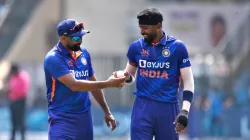How does saliva help in moving the cricket ball after Mohammed Shami voices to revoke its usage? Explained
Mohammed Shami voiced for revoking the ban of saliva usage on the cricket ball. Shami said that the bowlers try hard to reverse swing the ball, but the absence of saliva usage makes it hard. But how does saliva help in doing that? Check a detailed explainer here.

Indian cricketer Mohammed Shami raised his voice to revoke the usage of saliva for generating reverse swing, which has become minimal these days.
Speaking after India's four-wicket win over Australia in the Champions Trophy 2025 semifinal, Shami highlighted the absence of reverse swing in the cricket ball after the saliva usage was banned due to the Covid-19 pandemic.
"We are trying [to get reverse swing], but the usage of saliva on the ball is not allowed," Shami told media after India's Champions Trophy semi-final win over Australia. "We keep appealing that we should be allowed to use saliva so that we can bring reverse swing back into the game and it becomes interesting," he added.
But how does saliva help in moving the ball?
How does a ball swing?
The swing of a cricket ball is the lateral movement of it on either side in the air before landing. The ball swings due to the difference in air pressure on either side. A new ball, which if held with the upright seam does not swing, however, when the seam is pointed towards one of the sides - left or right - it does swing.
A bowler needs to hold the seam pointing in the direction in which he/she wants the ball to swing. For an outswing, the seam needs to be pointed at the first slip area diagonally, with the rough side being on the left and the shiny one on the right.
There is science behind the swing of the ball. There is aero-dynamics involved in it. When the ball is released by the bowler, air flows around it. The air gets disrupted on the side with the seam, which causes turbulence.
The turbulent air gets trapped for longer with the ball and makes it swing in that way/direction.
How does a ball reverse swing?
The reverse swing is the opposite of the swing. While in normal swing, the ball moves into the direction of the rough side of the ball, it moves to the shiny side in reverse swing. Reverse swing only takes place when the ball is old.
In making the ball reverse, the saliva factor comes in. The bowling team shines one side of the ball with saliva and lets the other side get rough. When the ball surface is abrasive from one end and shiny from the other, with the ball having been quite old, it gets reverse.
In reverse swing, the ball swings in the direction of the shiny side and not towards the rough side.
Currently, cricketers use sweat to make the ball shine from one end due to the ban of saliva. However, it does not contain mucus and is not a great polishing agent.
